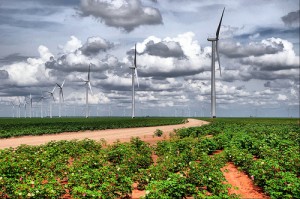The U.S. wind energy grew in 2009, despite a severe recession. There are 36 states that have utility-scale wind projects and 14 states are in the “Gigawatt Club” with more than 1,000 MW of installed wind capacity per state. In state rankings, Iowa leads in terms of percentage of electricity from wind power, getting 14% of its power from the wind, and also leads in highest number of jobs in the manufacturing sector. Texas consolidated its lead in wind capacity and in largest wind farms installed, according to the annual wind industry market report by the American Wind Energy Association (AWEA).
“Jobs, business opportunities, clean air, energy security—wind power is delivering today on all those fronts for Americans,” said AWEA CEO Denise Bode. “Our annual report documents an industry hard at work and on the verge of explosive growth if the right policies—including a national Renewable Electricity Standard (RES) — are put in place. A national RES will provide the long-term certainty that businesses need to invest tens of billions of dollars in new installations and manufacturing facilities which would create hundreds of thousands of American jobs.”
Highlights from AWEA’s new report include:
•The U.S. wind energy industry installed over 10,000 MW of new wind power generating capacity in 2009, the largest year in U.S. history, and enough to power the equivalent of 2.4 million homes or generate as much electricity as three large nuclear power plants.
•In industry rankings, GE Energy remained #1 in U.S. wind turbine sales; NextEra Energy Resources continued to lead in wind farm ownership; and Xcel Energy continued to lead utilities in wind power usage. At the same time, however, more companies are now active in each of these areas, showing that the wind energy market is diversifying as it expands.
•The report’s section on manufacturing shows that in spite of a slowdown in wind turbine manufacturing in 2009 compared to 2008, 10 new manufacturing facilities came online in the U.S. last year, 20 were announced, and nine facilities were expanded. The largest category was wind turbine sub-components, such as bearings, electrical components and hydraulic systems. In all, the U.S. wind energy industry opened, announced or expanded over 100 facilities in the past three years (2007- 2009), bringing the total of wind turbine component manufacturing facilities now operating in the U.S. to over 200.
•All 50 states have jobs in the wind industry.
•Approximately 85,000 people are employed in the wind industry today and hold jobs in areas as varied as turbine component manufacturing, construction and installation of wind turbines, wind turbine operations and maintenance, legal and marketing services, transportation and logistical services, and more.
•To ensure a skilled workforce across the wind energy industry, 205 educational programs now offer a certificate, degree, or coursework related to wind energy. Of these 205 programs, the largest segments are university and college programs (45%) and community colleges or technical school programs (43%).
•Despite the economic downturn, the demand for small wind systems for residential and small business use (rated capacity of 100 kW or less) grew 15% in 2009, adding 20 MW of generating capacity to the nation. Seven small wind turbine manufacturing facilities were opened, announced or expanded in 2009.
•Offshore wind power is gaining momentum in the U.S. The report lists seven projects with significant progress in the planning, permitting, and testing process. Both the federal government and several states established significant milestones in 2009 to encourage offshore wind power development.
•America’s wind power fleet of 35,000 MW will avoid an estimated 62 million tons of carbon dioxide annually, equivalent to taking 10.5 million cars off the road.
•America’s wind power fleet will conserve approximately 20 billion gallons of water annually that would otherwise be lost to evaporation from steam of cooling in conventional power plants.
Renewable Energy and Clean Transportation Reports


Wind energy has potential and we should harness it to what ever capacity we can, in the long run wind energy automatically pays for itself. It is one of the best methods to cut down on utility bills and the world’s carbon footprint. Unlike other power plants, wind energy systems require minimal maintenance and have low operating expenses. Many companies like Pacific Crest Transformers are working with the wind energy sector. Visit their site have some good information about the wind energy sector.